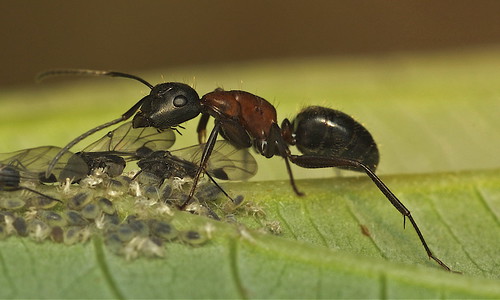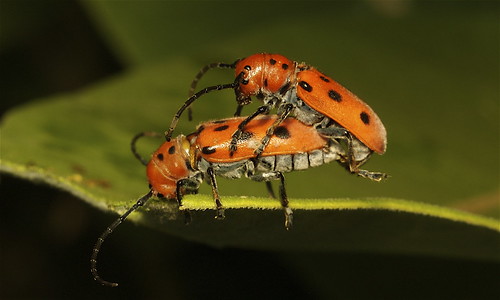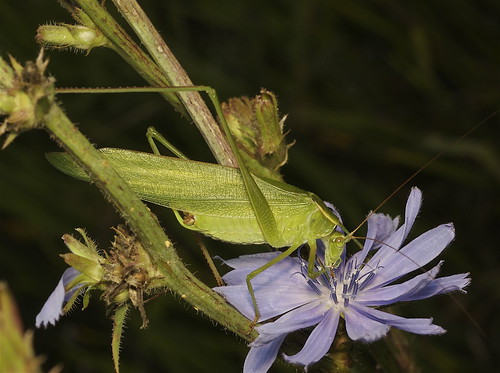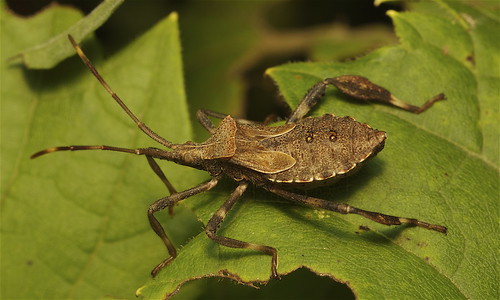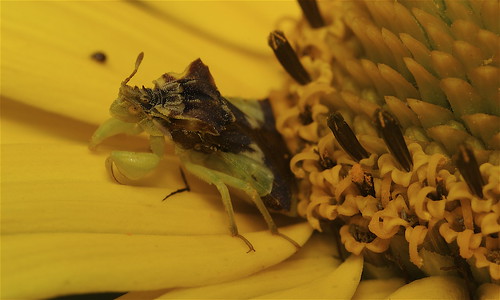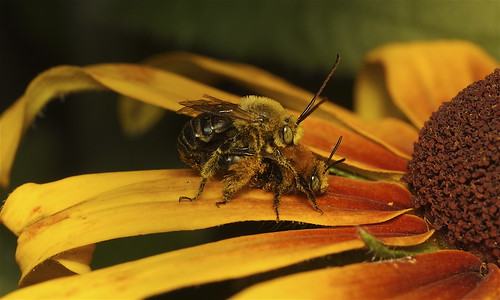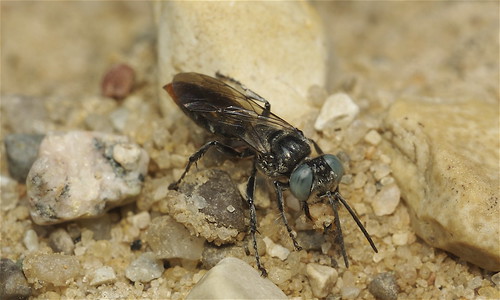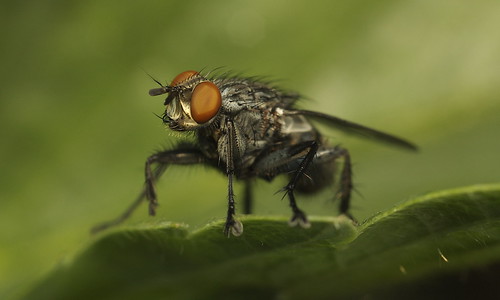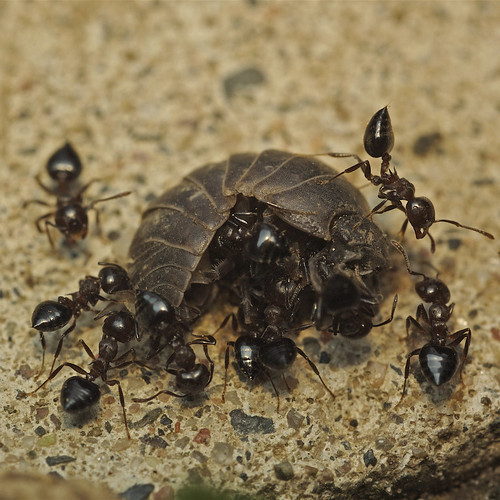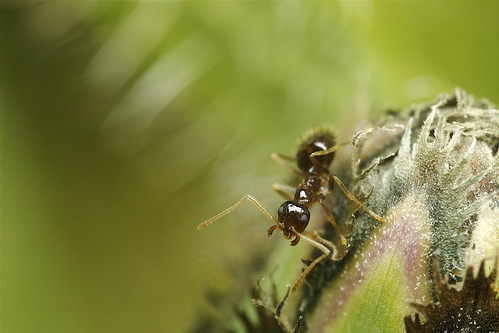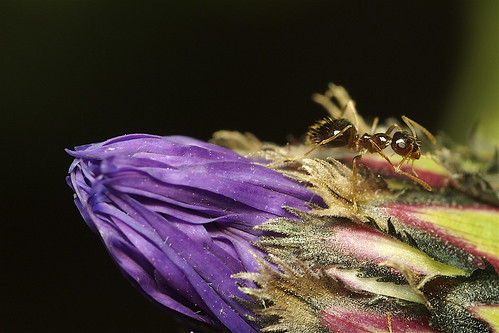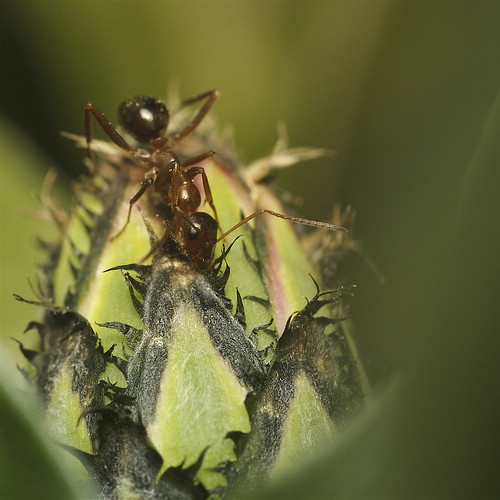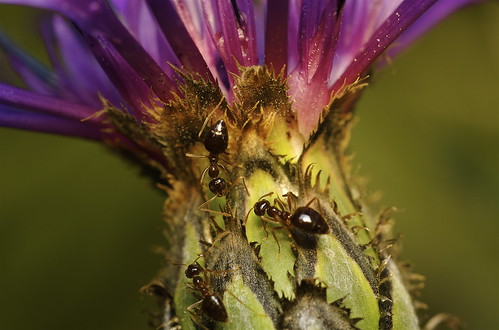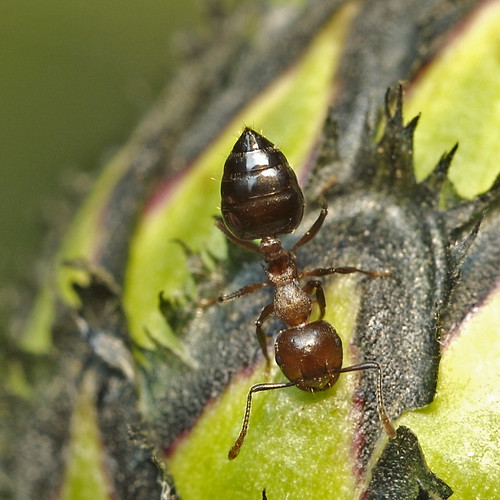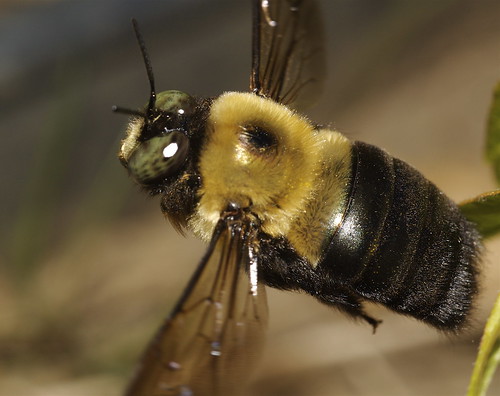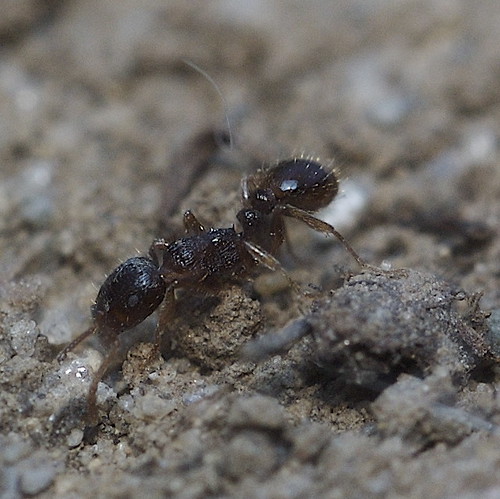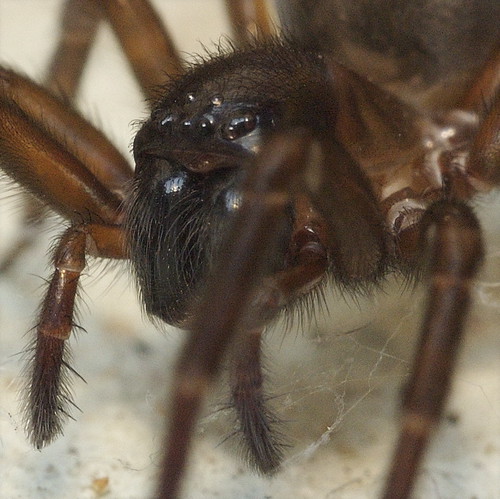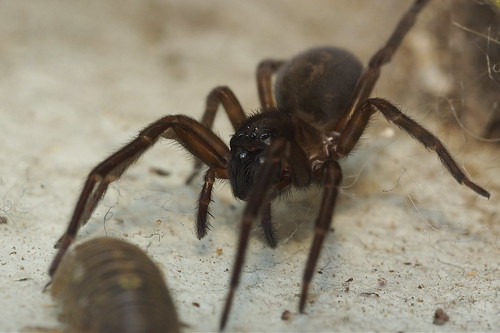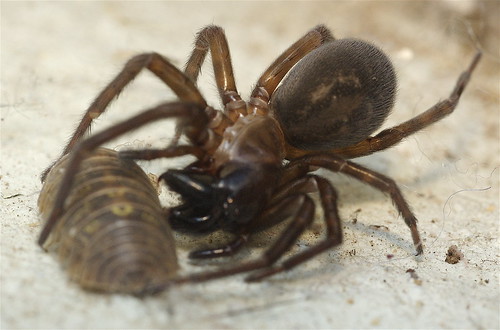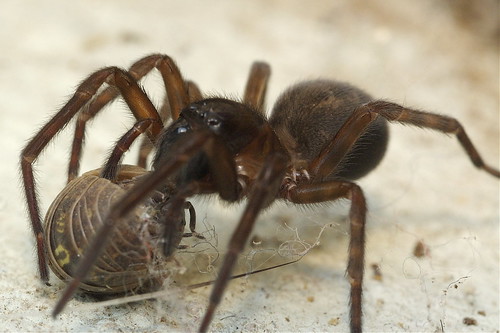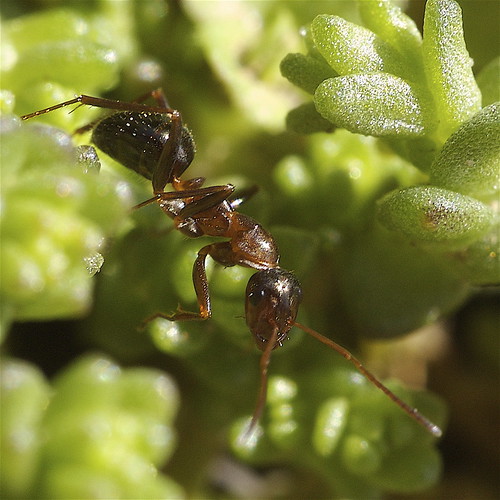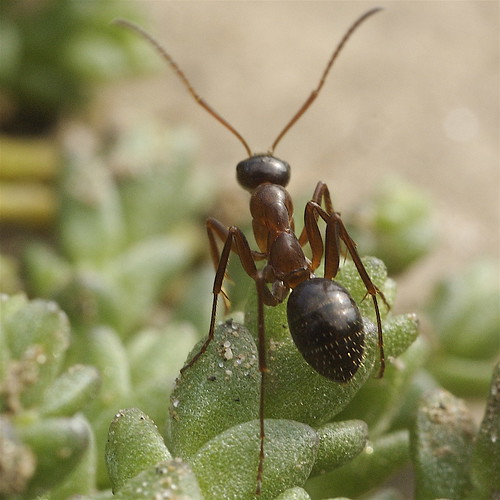This photo of a False Honey ant is unremarkable in that it is not too sharp and could be better lit. One thing I do like about it though is that it shows the ant's glossa (tongue) very clearly. I only recently learned what they were called. I believe they function to help ants drink up liquids. False Honey ants seem to be big fans of nectar from flowers and from aphids, so it makes sense that they would have proportionally large glossa. I believe they have two shorter and two longer strands to their glossa.
IMarsman
Ian Marsman's photography and technology blog
Wednesday, October 17, 2007
Carpenter ant - Camponotus sp.
This season I've been particularly engrossed by ants. Mostly I've taken photos of the False Honey ant (in spring and fall when they are active), and the Acrobat ant (very interesting behaviours and body morphology). I haven't gotten any shots of Carpenter ants, that is, until yesterday when I found one grooming aphids and feeding on their nectar.
This ant and the aphids were on the underside of a leaf (basswod I think, a tree noted for its attractiveness to sap-feeding insects). I turned it over and took lots of photos. Gravity means nothing to these creatures. Since I could move and hold the leaf as I pleased I was able to get some shots at face level that are otherwise difficult to get, including this good profile shot.
I bumped up the temperature a bit, as the late afternoon time of the shot desaturated things. You can see its glossa (tongue parts) at the base of its head. I love the way its left rear leg stretches out.
Friday, October 12, 2007
Obscure Sap beetle - Conotelus obscurus
Finally got another shot of the Obscure Sap beetle, again in my neighbour's front yard. It's a teeny beetle. The images I've taken and posted on Flickr and buiggide.net seem to be some of the only ones on the 'net, certainly the clearest.
Wednesday, August 01, 2007
Red Milkweed Beetles - Tetraopes tetrophthalmus
Black-spotted red beetles are photogenic. Mating ones even more so. I was happy to find them, but the female seemed to be pretty unimpressed with the mating thing, preferring to focus her attention on eating, which is probably wise, given that she would need shortly to be producing and laying eggs. The male is determined, but looks a bit ridiculous.
Feeding katydid
This katydid was nonplussed at my presence and by the repeated photographs I took of it. I was pleased to capture it eating, pleased that it was eating from a beautiful chicory flower, and pretty pleased with how this photograph came out. On Safari, my current favourite browser, the colours and tone come out rich and well balanced. On Firefox and IE, browsers lacking ICC profile detection and associated rendering support, this photograph looks a bit overexposed and not so rich in colour.
Leaf-footed bug - Acanthocephala terminalis
Here's a fun bug, large for Ontario. It's a Leaf-footed bug, one of a large variety of related bugs that suck juices from plants. It's a bug in the truest sense of the word, being of the sub-order Heteroptera, having a sucking part, six legs, and other features, along with having a nymph phase rather than a true metamorphosis.
I had a bit of a hard time getting good shots of this individual. In typical avoidance fashion, it kept on moving away from the camera, hiding on the underside of the leaf. At this small scale, gravity is less of a consideration, certainly less of a hindrance.
Pennsylvania Ambush bug - Phymata sp.
Another use of bright and strong colour, though not as successful as with the Long-horned bees. I think this one doesn't work as well because the balance of bright and dark tends here too much to the bright.
Ambush bugs are very tricky to photograph, both because they are very very well camouflaged and because it's tricky, when photographing them, to know when you are in focus. I think this is because the eyes, which I normally use as my focal point, are soft and flat in colour, unlike the rest of their body, which is angular and rough and stippled. This photograph worked out well enough because I was able to get good focus on the head and shoulders and because the pale green of the bug contrasts with the orange-yellow of the flower. I made it a bit cooler to bring out the green.
If I ever went into entomology I might enjoy studying exactly how insects go about making themselves more difficult to see, beyond the obvious colour camouflage and not moving. I think it may turn out that some new ways are still to be found whereby insects take advantage of how the visual system of an observer works to make it more difficult to get a visual 'lock'.
Together briefly
This photo of two Long-horned bees mating on a flower is one of my favourite invertebrate photos in a while. It was taken offhandedly, though with carefully checked exposure, at the main building of the Royal Botanical Gardens in Hamilton.
I love the deep, rich colour and the fact that it draws the bees into the scene. The richness of tones reminds me of those one sees in Rembrandt paintings, tending towards the dark, but not too much to obscure. Rembrandt paintings, when I was young, used to strike me as too dark and sombre, but now, as I try to learn more about colour and tonal ranges, I tend to admire this sort of thing more. Perhaps doing strong tones while still allowing lighting in a scene to work so very well was Rembrandt's way of showing off.
Surfing Safari
 Though I may change my mind on this, I am switching from using Firefox to Safari as my browser of choice. Most of the reasons for this relate to aesthetics and colour handling. Safari, on my iMac, is generally more responsive and smooth than Firefox. Copied text in Safari has its formatting preserved, making the loss of the Aardvark plugin easier to live with. Passwords get saved in the system keychain. Managing bookmarks is easier and more comfortable. Text areas (in v. 3 beta) can be resized by dragging, a great feature. Search within a page highlights instances of found text very nicely. Safariblock, a free plugin, gets close enough to the functionality of Firefox's Adblock. In summary, Safari gets in the way less, letting me concentrate on the main things I am doing. Finally, though it's planned for version 3 of Firefox, Safari handles embedded ICC profiles for images now, making rendering of my Flickr images much much more beautiful.
Though I may change my mind on this, I am switching from using Firefox to Safari as my browser of choice. Most of the reasons for this relate to aesthetics and colour handling. Safari, on my iMac, is generally more responsive and smooth than Firefox. Copied text in Safari has its formatting preserved, making the loss of the Aardvark plugin easier to live with. Passwords get saved in the system keychain. Managing bookmarks is easier and more comfortable. Text areas (in v. 3 beta) can be resized by dragging, a great feature. Search within a page highlights instances of found text very nicely. Safariblock, a free plugin, gets close enough to the functionality of Firefox's Adblock. In summary, Safari gets in the way less, letting me concentrate on the main things I am doing. Finally, though it's planned for version 3 of Firefox, Safari handles embedded ICC profiles for images now, making rendering of my Flickr images much much more beautiful.
Friday, July 20, 2007
Possible Sidewalk Tiger Beetle - Cicindela sp.
There are so many species of Tiger Beetle in the world. I hope to run across as many of them as I can. This was a new one for me, found along a dirt road in a partially roughed out section of a new subdivision by my sister- and brother-in-laws' place. I was very pleased to be able to photograph it.
Burrowing wasp - Tachysphex sp.
I love photos of invertebrates doing things. Several of these burrowing wasps were busily, ah, burrowing in the sandy gravel along a roughed-out road. They would quickly dig the burrow, then spend quite a bit more time getting it just right. These wasps will paralyze an insect and bring it back to the burrow, laying their egg or eggs on it so that when hatching occurs, the new larva or larvae have something to sustain them.
Monday, May 28, 2007
What captivates
This Flesh Fly has a lot going for it, photogenically. It's got big red eyes that draw human attention. It's body is grey, allowing the red eyes to stand out even more. This shot has the fly's head cocked a bit and one leg lifted off the leaf. If one wants to identify an insect one wishes a clear view of all major body parts. Aesthetics come with a different set of values. Aesthetically, it's ok to have a sharp foeground and fuzzy background, in fact, it looks better that way. I always feel so sad for the poor pinned bugs curled up and dessicated on their pins.
Small Serengeti
I love this shot. Wish I'd had the flash up a bit more to get at detail for the ants close into the wood louse, but there's plenty there to tell a good story, nonetheless. The wonderful level of activity and interaction one can find just by looking down as one treads a path is awe inspiring. These Acrobat Ants were gathered around a wood louse, slowly picking it apart until I imagine they'd cooperatively carry it away. The one on top with her back arched is displaying in response to a threatened approach by an ant from another species. Besides lighting, focus was the most challenging aspect of this shot, as limited depth of field forced me to choose carefully what parts of the frame to highlight. I opted for the carapace of the wood louse and as many of the gathered ants as possible.
Wednesday, May 23, 2007
All that I got
There's a neat bee fly in our garden. He's brown and fuzzy. He tends to stay in one place for about ten seconds, then fly to a new spot or return pretty much to the same spot after flying around for a while. This bee fly is shy, so I've been trying to take a photo of him at much less than 1:1. This is the clearest I got, a photo captured just as he/she was taking off. I'm sad I didn't get more but happy I happened to get a clear shot of the takeoff.
Since I've moved from my obsession with photographing ants I've been having a bit of difficulty photographing things that aren't 5mm long. Ants, besides being small, are pretty horizontal, meaning that a lot can be captured with minimal depth of field. Bees on flowers or larger flies, wasps, and bees in general, are difficult to capture doing something ineresting at 1:1 magnification. Either depth of field limitations ruin important detail or interesting context just doesn't fit. I'm having to experiment with less than 1:1 magnification, flash levels, and aperture to keep getting good bokeh.
Friday, May 18, 2007
Frustration and reward
How can I take credit for interesting shots of tiny creatures? All I have to do is walk out my front door, sit down on an overturned bucket, and take a few dozen pictures. A few always turn out well. Ants have caught my attention in a big way for the past few days. I've discovered that there are at least five species in our front yard and driveway alone, something I never would have guessed had I not begun to photograph them. False Honey Ants and Acrobat Ants are the two species that graze on the sweet setae (hairs) that grow from the buds, leaves, and stems of the Bachelor's Button plants in our front garden. The individuals in this photo are False Honey Ants, engaging in a brief moment of contact to ensure they are indeed from the same colony. I have a Nikon D50 camera with a Micro Nikkor 60mm lens. This gives me 1:1 capability. Yesterday, I added in a clip-on Raynox M250 closeup lens, which finally gave me eye detail. The combination of equipment and settings is reasonably simple and leads to good results if one keeps at it. The other factor is an interest in finding good subjects and taking the time to get to know them and take lots and lots of photos of them. This shot was taken with onboard flash diffused through the plastic of a vinegar bottle after 5:00 PM. To compensate for the reduced light I bumped the ISO to 400. I've found that increasing ISO helps with exposure but does lead to slightly increased graininess particularly noticeable on out-of-focus areas.
False Honey Ant clearing food from its jaws
Cant' stop photographing these little wonders. Good for both my photographic technique and my soul. Apparently, False Honey Ants eschew weather that's too warm, preferring to come out when it's cooler and lay low when it gets too hot. They have taken over the Bachelor's Buttons in our yard. I still see some Acrobat Ants browsing on the flowers, but seemingly fewer and fewer. False Honey Ants are slightly larger than Acrobat Ants and thus a bit easier to capture photographically. They are also more apt to move about, making it tricky to get shots of them, but more likely that they will be interesting shots like this one. Acrobat Ants tend to spend their time with their heads down, not just down low, but pointing downward to the ground. Much more difficult for a giant like me to photograph.
Wednesday, May 16, 2007
Regurgitating
I need to learn more about what this ant is up to. It seems to be regurgitating its food. At first when I saw False Honey Ants I doing things with their forelimbs I thought that they were preeing. It turns out they were at least some of the time playing with their food.
Artsy
I like this shot. Ants don't tend to spend a lot of time near the flower part of the Bachelor's Button plant, so getting a shot of them there takes a bit of patience and a lot of tries. I had the camera angled for this shot, resulting in this sideways view that I decided not to correct. Things I like best about this shot include the purple of the emerging flower petals, the gentle folding of the petals, the black background of most of the shot, and the brown translucence of the False Honey Ant.
Lasius alienus
This is the ant very common in Ontario which one sees building and maintaining small ant hills in sandy soil. Found out this ant is a member of Lasius alienus. All-in-all I've found five species of ant in our front yard and dirt driveway so far this spring. Amazing what you find if you look.
Formica sp. - pallidefulva group
This ant is found foraging all over our front yard garden and driveway, bringing home dead insects, or getting a meal of nectar, as in this photo. I've submitted it for identification to bugguide.net. When it comes upon Acrobat Ants on a Bachelor's Button plant it is chased away. After this it tends ot run around the plant a bit then go back to where it encountered the Acrobat Ants, only to be chased away again.
False Honey Ants - Prenolepis imparis
Here are some False Honey Ants gathering nectar from extrafloral nectaries on a Bachelor's Button plant. Extrafloral nectaries are growths that are rich in sucrose and tend to attract s of ants. It is presumed that extrafloral nectaries serve to protect the plant from unwanted pests, as the ants will chase off other insects. Note that False Honey Ants have large abdomens, an indication that they tend to ingest food that will later be shared with the colony.
Pavement Ant - Tetramorium caespitum
Here's a Pavement Ant, not terribly poetically named. Its abdomen is much smaller than that of the Acrobat Ant, probably because it brings home scavenged food rather than ingested nectar. This one was "scavenging" another Pavement Ant that wasn't dead yet and vigorously resisted being carried along.
Acrobat Ant - Crematogaster sp.
I found out that this is an Acrobat Ant. I imagine its propensity for stooping down to eat made those who named it think of an acrobat. It has a rather large abdomen, presumably for holding food, and a spiny protrusion dorsolaterally on each side of its thorax.
Monday, May 07, 2007
Insect behaviour and tricky shots
It's tricky to get a good shot of an insect in mid-flight or any sort of closeup shot, for that matter. Getting a good shot often involves a bit of understanding of insect behaviour. Here are a few categories I've found.
- Insects that are really tired or are trying to warm up in the sun tend to let you get closer. This is especially true of spring insects like bee flies whose ability to function in cool spring air is only marginally possible. The fact that they're out at all is driven by a reproductive or foraging need. In the case of bee flies, they need to lay their eggs near those of solitary wasps so that their larvae can locate the wasp larvae and eat them.
- Insects that are busy mating often ignore pretty much everything going on around them in order to mate (thus, the proliferation of mating bug shots).
- Insects eating are less likely to be shy than those foraging (thus the dining spider and bee and butterly shots you see).
- Insects that think no one sees them and depend on immobility for safety tend to stay put (I just posted a picture of a well-camouflaged crab spider on a fruit tree displaying this behaviour).
Visual capture and colour
Flowers and colour are great attractants for people. I may love a shot of an ant carrying a dead worm or a spider, but not many others seem to. Post a picture of an Eastern Carpenter Bee resting on a tulip petal, though, and you've got peoples' attention. It's jaws close from the sides and seem to be well suited to the need to bite into wood, severing vertically running fibres.
Tuesday, May 01, 2007
Small things and the limits of cameral equipment
One of these macro issues I've just found out about is diffaction effects at small aperture settings. Here's a great article on the subject. Wikipedia has a nice article on part of the theory behind the issue. Essentially, the smaller the aperture allowing light to pass from the lens to the sensor or film, the more likely individual waves of light are to overlap with each other, creating fuzziness in the image. Other variables involved include the size of the sensor, the size of the individual sensor receptors, and the focal distance. Of course, the quality of the lens passing light to the sensor is an important factor as well. People say that one should be able to take good photos no matter what equipment one is using. This is true to a certain extent, of course. I am very happy with many photos taken with my previous non-SLR camera. However, smaller sensor size, smaller aperture, less sharp optics, and the inability to use flash made getting a sharp picture more difficult. The page I linked to above has a nice calculator that lets you figure out how small you can set your camera's aperture before diffaction effects manifest themselves. My camera at macro focal distance apparently can be set up to f14 or f16.
Availability of light is another issue with any photography. For my macro photographs when not in bright sunlight I've started to use my on-camera flash with a homemade diffuser at the end of the lens cut from a vinegar bottle. Unfortunately, with flash, the camera seems to want to set shutter speed to 1/60 second. At this speed motion blur can be an issue. I will try experimenting with setting ISO level to 400 or 800, seeing what using a wider aperture does, and when I am confident enough, setting shutter speed manually as well.
Another always-present issue with macro photography is the very shallow depth of focus one must deal with, also known as depth-of-field. Another nice page on the diffraction effects site (cambridgecolour.com) deals with depth-of-field. A nice calculator is included on this page as well that allows depth-of-field for varying focal lengths, subject distances, apertures, and camera sensor sizes to be estimated. At f16 I should get about a 5mm depth-of-field. At f14 I should get about 4.5mm. This means that taking a photo head-on of a 7mm ant at most 4 to 5 mm of the subject will be in sharp focus. Focusing at such close distances is tricky, so one often gets a situation where sharp focus begins a bit in front of the subject, so one might only get 2 or 3 mm of sharp focus. This explains why one sees lots of side-shots or top-shots of macro subjects. The area of interest all falls within the depth-of-field focal range for these shots.
Sunday, April 29, 2007
Mid swing
I took several shots of Nancy swinging from a vine at St. John's Conservation Area, having fun and reliving childhood memories. She and I both like this shot. She told me not to crop it. On reflection I agree.
Using Flash
Ok, I admit now that flash is useful in macro work. I had been one to poo-poo the use of flash. Perhaps this was doe to having seen too many over-lit photos. The other day out of curiousity I decided to find out what I could get out of the built-in flash for my Nikon D50. By itself, with lens extended all the way I got a shadowed section on about 20% of the photo where the flash could not reach. So, I rigged up a diffuser using a cutout from a vinegar bottle. It diffuses, of course, and also sends the light down where the onboard flash would otherwise be blocked. I've found that it works well to warm up my photos without being harsh. It also to allows me to freeze action and thus get better detail on my macro shots.
There are two funnel spiders in our basement, a male and a female. The male hangs out at the entryway to the funnel and the female hides inside. Nancy saw the male this afternoon and wanted to kill it. Janneke loved it, as did I. Without flash it would have been impossible to photograph in our basement. However, with the flash and diffuser, I took some pictures. At this point Janneke decided she wanted to feed the spider. She found a wood louse and we put it by the lair. That's when we saw the female for the first time, emerging from the funnel web. The male kept his distance and absolutely ignored the food. He obviously only wanted to mate. The female grabbed the louse and quickly retreated with it to the funnel. She also did this with some Milkweed Bugs we gave her too.
Wednesday, April 25, 2007
Descending
Here's an ant going down the other side of an obstacle. Amazing ability to traverse terrain. Looking at this one, you can see that ants are well designed for strength. It's body is rigid and its legs provide great leverage. Just amazing.
Alone
One of my best insect photos. This ant was pausing at the crest of a plant branch before beginning her descent. Standing at the crest of a hill and looking over the horizon is something that people can identify with. The sky was overcast when shooting this photo, so glare is reduced, both on the ant and the succulent plant that in sunlight produces lots of points of glare.

